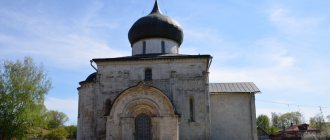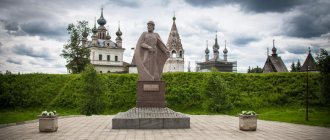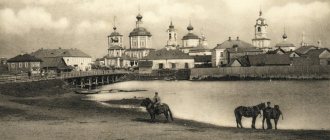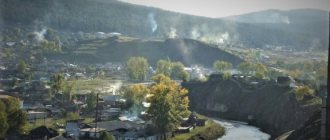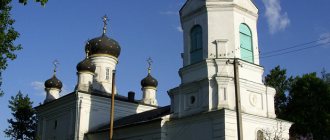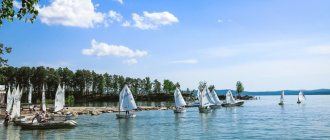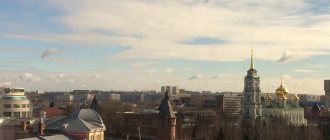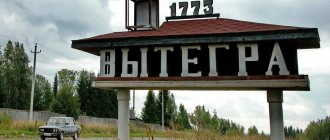A few facts about Yuriev-Polsky
- Yuryev-Polsky is located on the Koloksha River. The founder of the city is Prince Yuri Dolgoruky (creator of the city of Moscow), thanks to whom the wooden Yuryev-Polsky Kremlin appeared on this site in 1152.
- The city received its name from the name of the prince. But since the settlement of Yuryev already existed in the vicinity of Kyiv, the second part “Polish” was added to the name, denoting the endless number of fields lying near the city.
- The following films were filmed in Yuryev-Polsky: “The Golden Calf” (1968), “The Seventh Day” (2005), “Yuryev Day” (2008) by Kirill Serebrennikov, “Russian Chocolate” (2010), “Marriage by Will-2. The Return of Sandra" (2011), "Walk, Vasya!" (2017), "Grail" (2018).
- The city's population is approximately 18.5 thousand people.
- The distance to the regional center of the city of Vladimir is 69 km, to Suzdal - 62 km, to Alexandrov - 75 km.
Name
In the chronicles, the city was originally called Gyurgev or Gergev - after its founder Yuri Dolgoruky. The second part of the name - from the word “field”, the city stands on the Suzdal opole - appeared to clarify the location, due to the existence of other cities with the same name during this period: until 1224 - Yuryev (Tartu), and from 1224 - Yuryev- Povolsky (Yuryevets), Yuryev in the Dnieper region, located in the southern patrimony of the Suzdal princes (now the city of Belaya Tserkov).
The parallelism of the names “Yuryev-Polskaya” and “Yuryev-Polsky” is recorded, in particular, in the form of two spelling options for the name of the city in the TSB. Currently, on all maps and in official documents the city is called Yuryev-Polsky.
St. Michael the Archangel Monastery and Yuriev-Polsky Museum
Website: yp-muzeum.ru Address: Yuryev-Polsky, st. 1 May, no. 4. Opening hours: from 9.00 to 17.00, on Monday until 14.30, closed on Tuesday and the last Friday of the month.
The Yuryev-Polsky Museum was opened on November 7, 1920 as a local history museum in the central part of the city, in the ring of ancient earthen ramparts of the 12th century, in the former St. Michael the Archangel Monastery, founded in the 13th century.
The surviving buildings date back to the 17th-18th centuries, and the western wall of the building dates back to 1555.
One of the most famous buildings on the territory of the former monastery is the hipped bell tower, built in 1683.
Cathedral of the Archangel Michael
To date, 16 thousand antiques and works of art are distributed across several exhibitions of the museum. Among them are things of aristocrats, porcelain, and wooden sculptures. The main exhibition is dedicated to the fight against Napoleon Bonaparte and the Patriotic War of 1812. The following exhibitions are on display: “Bagration - National Hero of Russia”, “Art Exhibition”, “Bell Tower. Observation deck”, “History of the Yuryev-Polsky district manufactory” and others.
The main attractions of the city of Yuryev-Polsky: what to see, where to go
This is a perfectly preserved corner of the Russian province with picturesque landscapes and archaic buildings. Being located close to Moscow, he managed to avoid the influence of the capital and remain authentic.
Of great interest are the ancient temples, earthen ramparts, and shopping arcades. On Krasnooktyabrskaya, 1 May and Vladimirskaya streets you can find stone houses built before the revolution.
In the vicinity of the settlement, ancient estates and temples have been preserved:
- "Varvarino";
- ensemble of the Kozma Yakhromsky monastery in the village of Nebyloe;
- "Apraksino" in Ratislovo;
- “Ganshino” in the village of Sekerino-Kosinskoye;
- Church of the Holy Trinity in the village of Fedorovskoye, etc.
The list includes more than 60 names of historical tourist sites.
The following archaeological sites are of great interest:
- “Two burial mounds” in the village of Adamovo;
- "Mstislavl" in Gorodishche;
- the “Selishche” memorial complex and the “Golden Bridle” mound in the village of Elokh, etc.
Opolye is the most beautiful part of Central Russia. Travelers often come here to admire the attractive scenery. But you won’t be able to get to most objects without a car.
St. George's Cathedral
St. George's Cathedral is one of the most ancient churches in Russia and one of the few surviving churches of pre-Mongol Rus'. Its history begins in the 12th century with a small church built by the founder of the city, Yuri Dolgoruky. On the site of the destroyed temple, a new cathedral was built in 1230-1234 by the princely decree of Svyatoslav Vsevolodovich, the grandson of Yuri Dolgoruky. It featured luxurious stone carvings, white walls and a huge black dome. Its appearance resembled the famous Church of the Intercession on the Nerl.
In 1460, the temple collapsed; the Moscow architect Ermolin was entrusted with its restoration. During the restoration, the proportions of the building were disrupted, some of the reliefs were lost, and some were mixed up. In the 18th-19th centuries, various extensions to the temple were built: a bell tower, a sacristy, and a chapel. They were demolished in the 20th century.
Svyatoslav cross
To this day, St. George's Cathedral preserves ancient shrines, valuables and artistic paintings. One of its main relics is considered to be the Svyatoslav cross - a princely crucifix made of stone, made in gratitude for salvation in a military campaign. An inscription about the erection of the cross by Prince Svyatoslav is carved on it.
Peter and Paul Monastery
The exact time of the founding of the Peter and Paul Convent is unknown; it appeared in the northern part of the city around the 16th-17th centuries. In the 19th century, a stone Peter and Paul Cathedral was built on the territory of the monastery, and a little later the Assumption Church, with a high five-tier bell tower, was erected nearby.
After 1917, the Peter and Paul Monastery was closed and the buildings were destroyed. Of all the former grandeur, only the five-tiered bell tower has survived. Today, the women's monastery is being revived.
Church of the Intercession of the Blessed Virgin Mary
Address: Yuryev-Polsky, Naberezhnaya street.
The Church of the Intercession was built in 1712 through the efforts of monk Kirill from the St. Michael the Archangel Monastery. Not far from the Church of the Intercession, the monk also erected a small number of wooden cells. But the monastery did not exist for long; soon the temple was turned into a parish church. In 1768, due to the fault of the servants, it completely burned down, although local residents managed to save the icons and utensils from the building. In just a year, the townspeople raised funds and built a new Church of the Intercession, which stands in Yuryev-Polsky to this day.
Temples and churches of the city
Yuryev-Polsky, like every ancient Russian city, is rich in churches. Many priceless examples of ancient architecture have survived to this day.
Church of the Nativity
- Address: per. Avant-garde.
The Church of the Nativity forms a single complex together with the Boris and Gleb Church. Services in the spacious five-domed Church of the Nativity of Christ took place in the summer, while the younger Church of Boris and Gleb was used during cold weather. The latter was significantly smaller in size, making it easier to heat. The low temple with small windows retained heat even in severe frosts.
During the Soviet years, both churches were looted and converted into dairy factory workshops, which greatly damaged the ancient buildings. The bell tower was dismantled to its foundations. After the collapse of the Union, restoration work began, which continues successfully to this day.
Church of the Life-Giving Trinity
- Address: st. May 1st.
One of the youngest temples in the city surpasses many ancient religious buildings in its scale and splendor. The luxurious red-brick cathedral with lush decoration in neo-Russian style marked the three-century anniversary of the Romanov dynasty. The temple did not last long; two years after the opening, the Revolution took place. The Soviet government did not spare the architectural masterpiece: the cathedral was beheaded and closed, church values disappeared without a trace. Several years ago the church was transferred to the Archangel Michael Monastery. At the moment, the cathedral is undergoing restoration.
Church of St. Nikita Martyr
- Address: st. Pokrovskaya.
The small, but very beautiful and cozy Nikitskaya Church was built at the end of the 18th century. The classic building attracts attention from afar thanks to the bright combination of white, red, green and blue colors. The outside of the building is decorated with antique porticoes with columns. The drum is dotted with numerous windows, thanks to which the inside of the temple is well lit even in cloudy weather.
The Temple of Nikita the Martyr was able to survive when the Bolsheviks came to power, but was closed at the beginning of the Great Patriotic War. A car repair shop opened on the premises. Where once there had been chants and the scent of incense, there was now the sound of metal clinking and the smell of exhaust fumes. In the year of the 1000th anniversary of the Baptism of Rus', the building was returned to the Church and completely restored. Today the church is open to believers.
St. George's Church (wooden)
- Address: Yuryevsky Kremlin.
A small log church of an unusual shape was built in the village of Yegorye (Egoriy) at the beginning of the 18th century. Talented architects created a temple without nails, using only axes. According to some sources, the church belonged to the St. George Monastery of the mid-16th century, which ceased to exist several centuries ago. In the mid-20th century, the building was transported to the Archangel Michael Monastery. A few meters from the church there is a small Nadkladeznaya chapel. A wooden chapel covers a well filled with water from a holy spring.
Intercession Church
- Address: st. Embankment.
The modern stone Church of the Intercession of the Blessed Virgin Mary stands on the site of a burnt wooden church built in 1712. According to the plan of its founder, monk Kirill, the temple was to become the center of the Intercession Convent, but the monastic community lasted only a few years. The nuns moved to the Holy Vvedensky Monastery, and the church became a simple lay parish.
After some time, a fire incinerated the wooden building. The new stone structure was erected in one year with donations from local residents. Already in 1769, the church opened its doors to parishioners.
In the 19th century, the temple was decorated with a magnificent three-tier bell tower with stained glass windows. After the Revolution, the architectural monument was turned into a workshop. In the 90s the temple was returned to the Church. Nowadays, many pilgrims from all over the country come to the Intercession Church to venerate the relics of the holy noble prince Svyatoslav Vsevolodovich, found shortly before the revival of the church.
Trinity Church in the village. Podolets
- Address: Podolets village.
The unique two-tier temple was erected in 1659 on the estate of the princes Miloslavsky. Inside there were four chapels: the Life-Giving Trinity, St. Joachim and Anna, ap. Andrew the First-Called and St. Mary of Egypt. Several members of the noble family are buried in the lower temple. The USSR did not appreciate the splendor of the church, and for many decades the ancient building was destroyed under the influence of natural elements. Today, thanks to the work of restorers, the temple has received a chance for a new life and is slowly being restored.
Church of Nikita the Martyr
The Church of Nikita the Martyr was built in 1796 in the classic style next to the Church of the Intercession. On three sides, the entrances to the temple are decorated with lush porticoes with columns. The church is famous for its tall drums with rows of narrow and tall windows.
In 1941 it was closed, and the building housed a bus station and a repair shop. In 1988 it was opened and consecrated again. Today the temple is a functioning Orthodox Church of Yuryev-Polsky.
Church of the Nativity and Boris and Gleb Church
In the inventory of the city of Yuryev-Polsky in 1613 and 1760. the Church of the Nativity is not mentioned; therefore, its foundation can only be dated to the end of the 18th century. In 1792, the cold stone church was consecrated in honor of the Nativity of Christ, with chapels in the name of the holy wonderworkers, unmercenaries Cozma and Damian, and in the name of the holy great martyr Paraskeva. The lane in which the temple stood was called Kokushkin and Kozmodemyansky. It received its last name from the temple, which local residents knew better as Kosmodamiansky, after the dedication of one of the chapels. There is an assumption that initially the entire temple was consecrated in honor of Cozma and Damian, and only after the addition of the bell tower was it reconsecrated in the name of the Nativity of Christ.
Church of the Nativity of Christ in Yuryev-Polsky
The Church of the Nativity of Christ is a relatively low quadrangle, topped with five large drums with onion-shaped domes. Attached to the quadrangle was a low refectory with a three-tiered massive bell tower, on which there was even a clock. The quadrangle of the temple is decorated with false zakomaras in the upper part, and all facades are divided into three parts by small blades. The already high drums are raised by the kokoshniks surrounding each drum. The bell tower was completely destroyed during Soviet times. Currently, the Church of the Nativity of Christ is active. In 1808, a warm stone church was built in honor of the holy princes-passion-bearers Boris and Gleb.
Boris and Gleb Church
Shopping arcades and Gostiny Dvor
On the northern side, the ancient earthen ramparts of Yuryev-Pokrovsky have been adjacent to the trading area for many centuries, which is now called “Sovetskaya”. On it there are stone buildings of the Trading Rows and the two-story Gostiny Dvor, built back in 1873-1877. They appeared instead of the burnt wooden buildings of Gostiny Dvor. The difference between the Yuryev-Polsky Trading Rows and the rows in Suzdal, Vladimir and Kostroma is the absence of a courtyard.
In the 19th century, the customers of Gostiny Dvor were local traders: merchants and manufacturers. Here they organized premises for trading and storing their goods. In the last century, the buildings housed shops, pubs, inns and warehouses. Now most of the shops are empty, and many of the awnings are rickety.
Almshouse of the Meshcherins
In 1904, with the funds of G.I. Meshcherin, a hereditary honorary citizen of the city, an almshouse building was built. It was expected that it would accommodate up to 160 people: for men and women of the bourgeois and merchant classes.
At the moment, the building is a cultural heritage site; it houses the Yuryev-Polsk Central District Hospital.
Monuments and memorial complexes
The monuments of Yuryev-Polsky are in one way or another connected with its rich history, however, as in other cities of the Central District, for example, Vladimir or Ryazan .
Monument to Yuri Dolgoruky
- Address: Vladimirskaya street.
The granite prince surveys his creation from a high pedestal on the main square of the city. The sculpture of the founder was installed in 2002. next to the current Honeymooners' Park. The founder of the city is depicted in full height, with majestic posture. With one hand he leans on the sword, with the other he holds a flowing cloak. Behind Yuri Dolgoruky are the domes of the Archangel Michael Monastery. At the foot of the pedestal, two stone lions bare their teeth - a symbol of power, courage and nobility.
Soldiers' Memorial
- Address: 1 May Street.
In a small park next to the Historical and Art Museum there is a white monument to all the soldiers and officers who died in the Great Patriotic War. On the right side of the sculptural composition, stern warriors are depicted, on the left - inconsolable mothers and wives. Men and women are separated by a grave stele topped with a star. The inscription on the monument reads: “No one is forgotten, nothing is forgotten.” The Eternal Flame is lit in front of the memorial. The monument conveys the grief of the residents of Yuryev-Polsky: out of 11 thousand townspeople, 8 thousand did not return from the war.
Monument to those killed in the Second World War
- Address: Naberezhnaya street.
Another memorial dedicated to the Great Patriotic War. The composition consists of five parts. In the center, on the gray monuments, a red granite star is burning, under it is a slab of the same material, repeating the shape of the Yuryev-Polsky region. The inscription on the plate reads: “Dedicated to our fellow countrymen.” On both sides there are four gray slabs with plaques, which indicate by name each Yuryevite who was awarded the title of Hero of the Soviet Union. Every year fresh flowers are laid at the memorial.
Monument to doctors
- Address: Central District Hospital district.
A modest monument was erected next to the Central Regional Hospital. The dark stone depicts a golden star in a wreath. The monument is dedicated to all medical workers, doctors and nurses who died at the hands of the German invaders during the Great Patriotic War.
Monument to the 850th anniversary of the city
- Address: 1 May Street.
A stone worship cross was erected near the walls of the Archangel Michael Monastery in the anniversary year of 2002. The monument is a tribute to the centuries-old history of the settlement, its rich Orthodox culture and the difficult trials that befell the local residents.
Topic: The best attractions of the Vladimir region
Monument to Yuri Dolgoruky
Address: Yuryev-Polsky, Vladimirskaya street
In 2002, on the 850th anniversary of Yuriev-Polsky, in the central part of the city, on the square near the defensive ramparts, a monument to Yuri Dolgoruky was erected. The author of the work was the sculptor Igor Chernoglazov.
The monument to the Yuryev-Polsky landmark is made of dark granite. The figure of the prince carved from stone stands at full height, and his gaze is directed into the distance. Around the pedestal with Yuri Dolgoruky sit his defenders - lions. They are located on both sides of the architectural complex.
Architecture and beautiful buildings
Yuryev-Polsky is a place of contrasts. Typical five-story buildings alternate with ancient buildings, thanks to which you can trace the development of urban architecture from ancient times to the present day.
Shopping arcades
- Address: pl. Soviet.
Trading premises, traditional for many Russian cities, appeared in Yuryev-Polsky in the 18th century. A hundred years later, a strong fire destroyed the wooden buildings, and soon a new building arose in their place, which has survived to this day. The Yuriev-Polsky ranks made a small contribution to domestic cinema: in the 60s of the last century, the film “The Golden Calf” with S. Yursky in the title role was filmed here. While walking along the Trade Rows, tourists can do two pleasant and useful things at once - examine the architectural monument and buy the necessary goods in the shops located in it.
Barn
- Address: per. Avangardsky, 3.
The unremarkable red building made of simple brick is an architectural monument of the 19th century. For a long time, merchant goods were stored here, but during the years of “dekulakization” the building was recognized as socialist property and turned into a city warehouse.
Fire station
- Address: Vladimirskaya st., 12.
The interesting brick building in the Gothic style has been well preserved despite its hundred years of age. The depot has been used for its intended purpose at all times, under any government. In some rooms dance evenings and theatrical performances were held, in others fire engines were waiting to be called. The gray building with its unusual shape stands out among other city buildings.
Almshouse of the Meshcherins
- Address: st. May 1st, 16.
The remarkable two-story red brick building was erected at the beginning of the 20th century with the money of local philanthropist G.I. Meshcherina. The almshouse accommodated more than 150 people of both sexes, mainly townspeople and old merchants. Currently, the former almshouse continues to benefit people: the central hospital of the region operates in the building.
Shevelkin Inn
- Address: 1st May Street, 33.
Good, memorable photos are also taken against the backdrop of this architectural landmark of Yuryev-Polsky. The building of the Shevelkins' inn was built approximately at the end of the 19th century, in the form of a two-story building with a blue and white facade and beautiful, bordered windows. The entrance is crowned by a pretty porch.
Khlebnikov's shop
- Address: st. 1st May, 4.
In the central part of the city, almost every building is an object of cultural heritage of municipal or federal significance. So is the former Khlebnikov Shop, built in the 19th century and a decoration of the city limits. As before, today there is a store offering food products here.
Newlyweds Park in Yuryev-Polsky
In 2010, a newlyweds’ park appeared in the city, laid out in honor of Saints Peter and Fevronia, patrons of family and marriage. The special features of the park are two large rings with the inscription “Advice and Love”, through which the newlyweds are invited to pass in order to seal their destinies.
Here are also located:
- a bench for two on which you can talk about your love or ask for forgiveness.
- brides' meadow, decorated in the form of a flower bed-heart. The bride and her bridesmaids are photographed there.
- “bridge of kisses” for a young family. Some people attach locks to the bridge to make the marriage last.
Neighborhoods of Yuryev-Polsky
The sights of Yuryev-Polsky do not end at the city limits. There are several other historical places located nearby.
How to get around Yuryev-Polsky
Yuryev-polsky is a small ancient city. If you wish, you can easily walk around it. All attractions are located close to each other. Also, a walk will allow you to take many interesting photographs, which are problematic to take from the inside of a car or bus.
The city has a well-developed taxi network. If you wish, you can call a car and get to the desired address. Prices start from 50 rubles.
Minibuses and buses run on schedule at different intervals - 15-20 minutes. To explore interesting places that are located outside the city, you can call a taxi or take a bus. Public transport departs from the bus station. You can find out the schedule in advance by phone.
Yuryev-Polsky has existed since the 12th century, so many of the attractions are represented by ancient buildings. In those days, religious culture was highly developed, which is reflected in the large number of temples and monasteries. The unique buildings have preserved the grandeur and spirit of those years, which can be felt when visiting.
Article design: Mila Friedan
The disappeared city of Mstislavl
Address: Vladimir region, Yuryev-Polsky district, Gorodishche village
11 kilometers north of Yuryev-Polsky, on the right bank of the Gza River, lie the ruins of an oval settlement with an area of 19 thousand square meters. They belong to the destroyed ancient Russian city of Mstislavl, which existed from approximately the 10th to the 14th centuries. They consist of a ring and an earthen rampart surrounded by 5-meter ditches.
It is assumed that in Mstislavl there were single-row log walls that reached 3 meters in height up to the fences, and together with the fences - up to 5 meters. The entrance to the settlement was from the north side.
An entry in the chronicle made in 1135 is the first mention of the fort. During the Golden Horde and the Mongol-Tatar yoke, in the 13th century, the settlement was devastated. The city was finally wiped off the face of the earth during Soviet rule, when the Church of the Nativity of Christ was destroyed on the territory of Mstislavl. Now the only building you can see here is a dilapidated four-tier bell tower, towering over the meadows.
Interesting places to relax with children
The city is perfect for a family weekend getaway. A walk along the picturesque streets with ancient buildings will enrich children's historical knowledge and bring special pleasure. The parks have rides where children can have fun. Adults can relax on the benches.
Stud farm Yuryev-Polsky
A unique breed of Vladimir heavy trucks, which are famous throughout the world, is bred on the territory of the stud farm. The breed has a kind and obedient disposition. Riding on such a horse will bring pleasure to both children and adults. It’s not every day that people are allowed to go horseback riding, but maybe you’ll get lucky.
The horse holds its rider calmly and confidently, does not break into a trot, but rather moves with a sedate and measured gait. A photo with a heavy truck in the background and the trip will be remembered for a long time. The plant is located at the address: Kosinskoye, Yuryev-Polsky district, Vladimir region.
Virtual reality park VR Play
The park consists of 3 playrooms dedicated to different themes. Here you can play in pairs or as a whole team of several people. Role-playing quests are regularly organized, in which adults often participate with pleasure. The organizers offer to celebrate the birthday in an original way. Therefore, children will be delighted with visiting this establishment.
The park is located at the address: st. Bolshaya Moskovskaya, 14. Prices start from 500 rubles. for one child.
Entertainment center Ratibor
This center teaches children shooting from different types of weapons. They talk about weapons - what types there are, how to care for them, lessons on shooting ranges. Here, for a fee, you can practice precision shooting at a target with an instructor for several hours. Boys will definitely enjoy this kind of entertainment, and girls will not remain indifferent.
The center is located at: st. Dvoryanskaya, 27A, bldg. 17.
Golitsyn Estate
Address: Vladimir region, Yuryev-Polsky district, Sima village, Pervomaiskaya street
The small village of Sima was given to General Mikhail Golitsyn as a gift from Emperor Peter I for his military services. The general ordered a house with outbuildings to be built here, a park to be laid out and a pond to be dug.
In 1812, the great commander Pyotr Bagration, a relative of the Golitsyns, spent his last days here. After being seriously wounded during the Battle of Borodino, Bagration came to Sima, where he died. His body was buried near the rural church of St. Demetrius of Thessalonica. His remains were later reburied.
After 1917, the Golitsyn noble estate turned into an orphanage. Today there is a library, a local House of Culture, and a museum named after Peter Bagration.
Notable natives
- Nikon of Radonezh (1350-1426) - Venerable. Holy Russian Orthodox Church. The second abbot of the Trinity-Sergius Monastery after St. Sergius of Radonezh.
- Sokolov, Andrei Konstantinovich (1941-2015) - Soviet and Russian historian, specialist in the field of source studies and methodology of modern Russian history.
- Fomin, Nikolai Sergeevich (1895-1987) - Soviet military leader, Colonel General of Artillery. Hero of the Soviet Union.
- Yakimovich, Roman (1889-1951) - Polish archaeologist.
Apraksin Estate
Address: Vladimir region, Yuryev-Polsky district, Ratislovo village
The once rich Apraksin estate in the village of Ratislovo, built in the 18th century, has been partially preserved. Before the revolution, there was a three-story mansion with two outbuildings for servants and the Kazan Church. A large park was landscaped for the noble family, on the territory of which there were 8 large ponds.
Of all the buildings, only the house has survived, which has already lost its beauty and grandeur, the luxurious interiors are irretrievably lost. Now it houses a correctional boarding school. Ponds and alleys have been preserved, the Kazan Church was rebuilt in 2012.
St. Vvedensky Nikon Monastery
Address: Kalanchevsky lane, building 5
The Holy Vvedensky Convent was created in 1628 and almost all the time that has passed since then has been developing and being completed. Now on its rather vast territory there are many different buildings of different eras, which allow us to trace the development of architectural thought in Russia. Currently there is a functioning monastery here.
